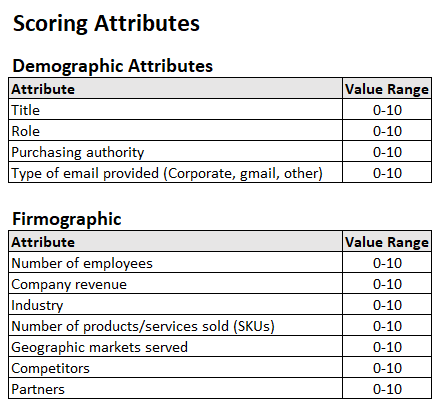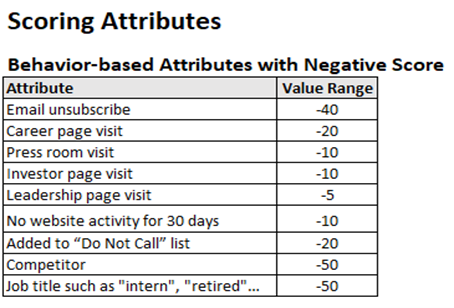In this short post I want to review the what an Account Score is and what elements that you want to include to develop an Account Scoring Model.
First, we need to define what a Lead Score is, and how that can influence and build the Account Score.

A lead score is based on an “individual”. This includes the activities you can track that they take – such as filling out a form on your website, the type of pages and number of times they visit your website, downloads of gated content, request for trials, if they clicked on your blog posts, etc. To calculate the Lead Score, each of these behaviors would have a point associated with it. One thing to note – points can be negative as well as positive. For an example of a negative score on a lead, we’d want to lessen the disposition if someone visits your career page. A lead who fills out a demo request should not be considered a good sales lead as they may be viewing the multiple different pages to research as a potential candidate for a position.
An Account Score takes into consideration the associated lead/contact scores, but also applies the overlay methodology of firmographic & demographic data of your ICP, or Ideal Customer Profile.
Why Use Accounts Scores, not just Lead Scores?
If you are a B2B business, you sell to a company where most buying decisions would be made by a group of individuals or committee. The lead score is designed to rank or score only an individual contact’s interest and if they would be willing to buy. (In a latter post I discuss the seven sales types you face in the buying process).
For a successful B2B sales process and at the top of the funnel you need to sort the potential customers into three buckets; those you want to pursue, those that need to be nurtured, and those to throw out, this is where the ICP is of most value.
In building the scoring model you can create a manual spreadsheet and enter the criteria with the aforementioned demographic, firmographic, and behavioral data, or if your company is more advanced you can use AI programs such as 6sense, Bombora, Infer, or Clearbit to assign these values in an automated fashion once you are able to build out your models.
No matter the tool you use, you need to remember that scoring is an ever-evolving process and you need to revisit your methodology often.
Here is an example of a scoring model.
- Rate the Demographic and Firmographic data using a scale of 0 to 10.

- Now look at the contact/leads behavioral components (note, these are values you will decide with your team and are hard coded in the score).

- Do not forget to add any negative scores to the total.

This list in not exhaustive, and you may want to add or even subtract different attributes, such as a social media presence, and so on.
To simplify this even further here are 2 tables that provides the scores based on firmographic data and then the output when adding the behavioral data attributes of 1 individual.
For Account Scoring you then add all of these scores up and divide by the number of contacts (individuals) in the account. Remember that as each individual in an account engages with your company, your Account Scoring will be affected by a contact’s Lead Score.
Your Account Scoring is not a single exercise, but something you will come back to often. For example, keep an eye on your conversion ratio’s – if you see fewer conversions, the scoring model could be set to low and will need to be refined.
Do not reach for perfection but for accuracy. You should be constantly updating not only your scoring model, but your ICP and your Buyer Personas. This will increase your odds of engaging those companies that will buy from you, stay with you and lead to your success.
Leave a Reply